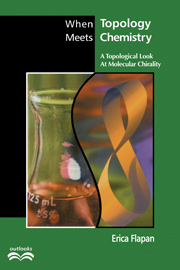4 - Different Types of Chirality and Achirality
Published online by Cambridge University Press: 05 June 2012
Summary
So far we have seen several different concepts of chirality and achirality. There is the experimental concept, which defines a molecule to be achiral if it can chemically change itself into its mirror image. There is the geometric concept, which defines a rigid graph to be achiral if it can be superimposed on its mirror image. Finally, there is the topological concept, which defines an embedded graph to be topologically achiral if it can be deformed to its mirror image. In this chapter, we introduce some additional approaches to achirality, which are topologically rigorous but try to capture some aspects of the rigidity of molecular structures.
Recall from Chapter 1 that the experimental concept of chirality does not necessarily coincide with the geometric concept. For example, we saw in Chapter 1 that Mislow's biphenyl derivative (Mislow & Bolstad, 1955) could chemically change itself into its mirror image, but its molecular bond graph could not be rigidly superimposed on its mirror image (see Figure 4.1).
A symmetry presentation of a graph is an embedding of the graph that can be rigidly superimposed on its mirror image. Building on a paper of Van Gulick which was originally written in 1960 and only published in 1993, Walba (1983) called a molecule a Euclidean rubber glove if it could chemically change itself into its mirror image but chemically it could not attain a symmetry presentation.
- Type
- Chapter
- Information
- When Topology Meets ChemistryA Topological Look at Molecular Chirality, pp. 110 - 135Publisher: Cambridge University PressPrint publication year: 2000



